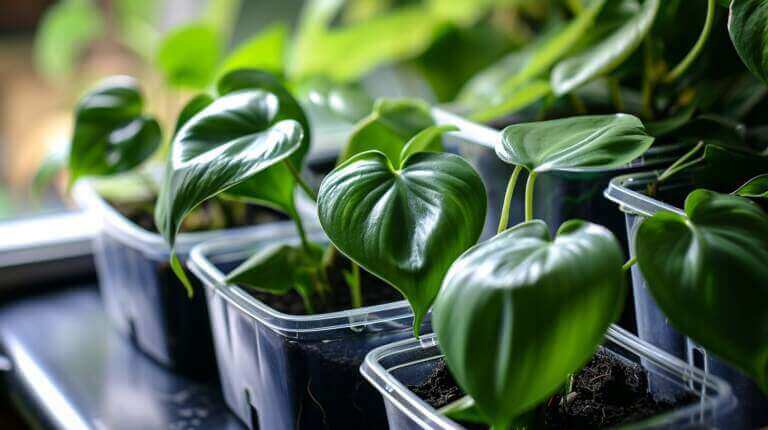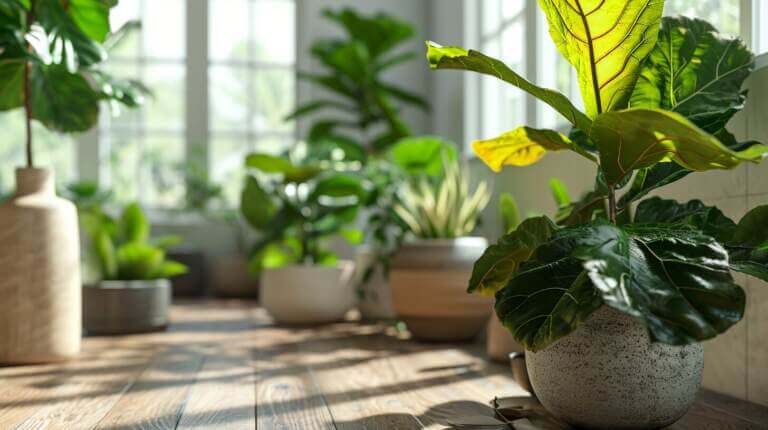What’s the Best Potting Soil for ZZ Plants? Soil Mix Tips for Healthy Growth
Discover the secret to thriving ZZ plants with the perfect soil mix.
In this informative article, we will explore the ideal components for healthy growth, emphasizing the importance of well-draining soil and enhanced nutrient absorption.
By maintaining optimal moisture levels, you can ensure your ZZ plants flourish in their environment.
Join us as we unveil the best soil tips to create a sense of belonging for both you and your ZZ plants.
Key Takeaways
- ZZ plants prefer well-draining soil that retains some moisture
- Well-draining soil prevents waterlogging and root rot
- Organic matter improves nutrient retention and soil structure
- Regular monitoring and appropriate watering techniques are crucial for ZZ plant health
Understanding the Potting Soil Mix For ZZ Plants
In order to fully comprehend the soil needs of ZZ plants, it is crucial to conduct thorough research and experimentation over an extended period of time. Understanding the soil composition and watering techniques that promote healthy growth is vital for any aspiring ZZ plant owner.
ZZ plants, also known as Zamioculcas zamiifolia, are native to Africa and have become popular houseplants due to their ability to thrive in low light conditions and tolerate neglect. When it comes to soil composition, ZZ plants prefer a well-draining mix that retains some moisture but doesn’t become waterlogged. A combination of peat moss, perlite, and potting soil is often recommended to provide the ideal growing medium.
Watering techniques also play a crucial role in the health of ZZ plants. These plants are succulent in nature, storing water in their rhizomes, which makes them more tolerant of drought conditions. Overwatering can lead to root rot and other fungal diseases, so it’s important to allow the soil to dry out between waterings. A good rule of thumb is to water ZZ plants when the top inch of soil feels dry to the touch.
Choosing the Best Potting Soil for ZZ Plant
The selection of appropriate soil components is crucial for healthy ZZ plant growth, as it directly impacts the plant’s ability to absorb nutrients and retain moisture. When it comes to soil composition for ZZ plants, there are several potting mix options to consider:
- Well-draining soil: ZZ plants prefer soil that is well-draining to prevent waterlogging and root rot. This can be achieved by using a mix that includes perlite or pumice to improve drainage.
- Organic matter: Incorporating organic matter into the soil promotes nutrient retention and improves soil structure. Compost or well-rotted manure can be added to the potting mix to provide these benefits.
- Balanced pH: ZZ plants prefer slightly acidic to neutral soil conditions. Testing the pH of the soil and adjusting it if necessary can help create an optimal growing environment for these plants.
- Aeration: Proper aeration is essential for the roots of ZZ plants. Including materials like vermiculite or coarse sand in the potting mix can improve aeration and prevent compaction.
Choosing the right soil components for ZZ plants is essential for their overall health and growth. However, one specific aspect that cannot be overlooked is the importance of well-draining soil for ZZ plants.
The Importance of Well Draining Soil Mix for Your ZZ Plants
Proper drainage is crucial for ZZ plants, as it directly affects their overall health and growth. ZZ plants, also known as Zamioculcas zamiifolia, are popular houseplants known for their ability to thrive in low-light conditions and tolerate neglect. However, one of the most important factors in their successful cultivation is the type of soil they are planted in.
When it comes to ZZ plants, well-draining soil is essential. This is because these plants are prone to root rot if they are consistently exposed to excessive moisture. Poor drainage can lead to waterlogged soil, which prevents oxygen from reaching the roots and can cause them to rot. To prevent this issue, it is important to choose a soil mix that allows water to flow freely through the potting medium.
Improving soil fertility is another key aspect of maintaining healthy ZZ plants. Regularly fertilizing your ZZ plants can help provide them with the necessary nutrients for optimal growth. A balanced, slow-release fertilizer specifically formulated for houseplants can be used to provide a steady supply of nutrients over time.
Troubleshooting common soil issues is also important for ZZ plant care. If you notice your ZZ plant’s leaves turning yellow or drooping, it could be a sign of overwatering or poor drainage. In this case, you may need to adjust your watering habits or repot the plant in a more suitable soil mix.
Enhancing Nutrient Absorption With Best Soil Mix
Using an optimal soil mixture can significantly increase nutrient absorption for healthier plant growth. When it comes to ZZ plants, choosing the right soil mix is crucial for improving root development and promoting microbial activity. Here are four key tips to consider when creating the perfect soil mix for your ZZ plant:
- Well-draining soil: ZZ plants prefer soil that allows excess water to drain away quickly. This helps prevent root rot and allows oxygen to reach the roots, promoting healthy growth.
- Organic matter: Adding organic potting soil matter, such as compost or well-rotted manure, can improve soil structure and provide essential nutrients for the plant. It also enhances microbial activity, which aids in nutrient breakdown and absorption.
- Perlite or pumice: Incorporating perlite or pumice into the soil mix can improve drainage and prevent compaction. These materials create air pockets in the soil, allowing the roots to breathe and grow more effectively.
- Balanced pH: ZZ plants thrive in slightly acidic to neutral soil. Testing the pH of your soil mix and adjusting it if necessary can ensure optimal nutrient availability for the plant.
By following these tips, you can create an ideal soil mix that maximizes nutrient absorption and supports the healthy growth of your ZZ plant.
Now, let’s explore how to maintain optimal moisture levels in ZZ plant soil.
Maintaining Optimal Moisture Levels in ZZ Plant Soil
To ensure the ZZ plant’s soil remains at its optimal moisture levels, it is essential to regularly monitor its hydration and implement appropriate watering techniques. Maintaining a moisture balance is crucial for the health and growth of ZZ plants, as both overwatering and underwatering can lead to problems. Overwatering can cause waterlogging, which deprives the roots of oxygen and can lead to root rot. On the other hand, underwatering can cause the plant to become dehydrated and wilt.
To help maintain the moisture balance in ZZ plant soil, it is important to use well-draining soil that allows excess water to flow out easily. A good soil mix for ZZ plants consists of a combination of peat moss, perlite, and potting soil. This mixture creates a light and airy environment that promotes proper drainage.
In addition to using the right soil mix, it is important to water ZZ plants correctly. The frequency of watering will depend on various factors such as the size of the pot, ambient humidity, and the plant’s growth stage. It is important to allow the top inch or two of soil to dry out before watering again. This prevents waterlogging and ensures that the roots have access to oxygen.
By maintaining the moisture balance and preventing waterlogging, ZZ plants can thrive and grow in optimal conditions. Regular monitoring and appropriate watering techniques are key to the health and success of these beautiful plants.
| Tips for Maintaining Optimal Moisture Levels in ZZ Plant Soil | |||
|---|---|---|---|
| Use well-draining soil mix | Water correctly and avoid overwatering | Allow top inch or two of soil to dry out before watering again | Monitor soil moisture regularly |
Frequently Asked Questions
What Type of Soil Should I Use When Propagating ZZ Plant Cuttings?
When propagating zz plant cuttings, it is crucial to choose the right type of soil. Opt for a well-draining mix that retains some moisture, such as a combination of peat moss, perlite, and sand. This will provide the ideal medium for the roots to develop and grow, ensuring successful propagation of ZZ plant cuttings.
How Does the Choice of Soil Affect the Bushiness of ZZ Plants?
The choice of soil greatly impacts the bushiness of ZZ plants. Using a well-draining soil mix that retains some moisture is essential for optimal growth. The keyword how to care for zz plant highlights the importance of selecting the right soil, as it directly influences the plant’s overall health and appearance.
Can Repotting My ZZ Plant Help Improve Its Soil Quality?
Are you wondering if repotting your ZZ plant can enhance its soil quality? Look no further! Follow these step-by-step repotting instructions for zz plant to ensure a successful improvement in your plant’s soil. With proper repotting, you can provide fresh nutrients and enhance the soil’s drainage, leading to healthier growth for your ZZ plant.
Can Repotting My ZZ Plant Help Improve Its Soil Quality?
Are you wondering if repotting your ZZ plant can enhance its soil quality? Look no further! Follow these step-by-step repotting instructions for zz plant to ensure a successful improvement in your plant’s soil. With proper repotting, you can provide fresh nutrients and enhance the soil’s drainage, leading to healthier growth for your ZZ plant.
What is the best soil for ZZ plants?
The best soil for ZZ plants is a well-draining potting soil mix. A mixture of standard potting mix and cactus soil can provide the good drainage that these plants need.
How do I know if I’m using the wrong soil for my ZZ plant?
If your ZZ plant doesn’t seem to be growing well or shows signs of stunted growth, you might be using the wrong soil. ZZ plants don’t like soggy soil, so a soil that retains too much water could be harmful.
What type of potting mix should I use for my ZZ plant?
A mix of standard potting soil and cactus mix is ideal for ZZ plants. This type of mix ensures good soil aeration and drainage, which is crucial for the plant’s health.
Can I use cactus soil for my ZZ plant?
Yes, cactus soil can be part of your ZZ plant soil mix. It helps ensure the soil drains well and doesn’t stay too wet, which can lead to root rot.
How often should I repot my ZZ plant?
You should repot your ZZ plant when it becomes root bound or when the soil is depleted. However, ZZ plants grow slowly and don’t need to be repotted often.
What kind of care does a ZZ plant need?
ZZ plants are easy indoor plants to care for. They need indirect light, infrequent watering, and well-draining soil. Overwatering can lead to yellow leaves and root rot.
Can I use succulent soil for my ZZ plant?
Yes, succulent soil or a mix that includes succulent soil can be used for your ZZ plant. Like cacti, succulents and ZZ plants all prefer well-draining soil.
Why are my ZZ plant’s roots rotting?
Root rot in ZZ plants is usually a sign of overwatering. If the plant sits in waterlogged soil, the roots can rot. Using a well-draining soil mix can help prevent this problem.
What Type of Soil Should I Use to Prevent Black Spots on ZZ Plant Stems?
To prevent zz plant black spots on stems, it is crucial to choose the right type of soil. Opt for a well-draining option, as excessive moisture can lead to fungal issues causing black spots. A mix of peat moss, perlite, and sand works well. Maintaining proper watering habits and good air circulation can further enhance the plant’s health and prevent black spots from appearing on ZZ plant stems.
How do I choose the best soil for my ZZ plant?
When choosing soil for your ZZ plant, look for a well-draining mix that won’t stay soggy. A mix of standard potting soil and cactus or succulent soil often works well.
What happens if I use the wrong soil mix for my ZZ plant?
Using the wrong soil mix can lead to waterlogged soil and root rot. If the roots are constantly wet, they can rot and the plant may die.







